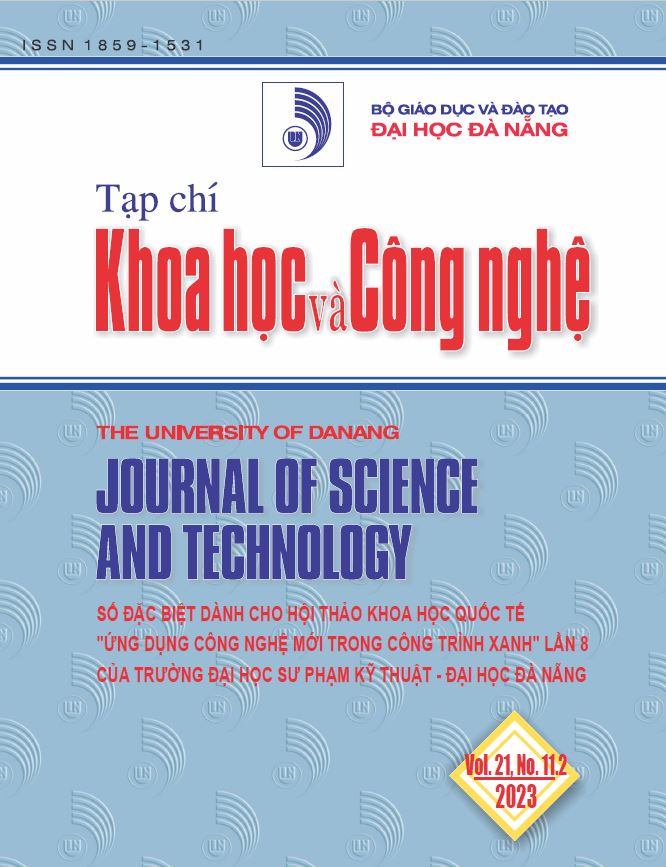Bước đầu nghiên cứu thu nhận bột màu vàng tự nhiên chiết xuất từ quả dành dành (Gradenia jasminodes Ellis)
 Tóm tắt: 625
Tóm tắt: 625
 |
|  PDF: 546
PDF: 546 
##plugins.themes.academic_pro.article.main##
Author
-
Nguyễn Hữu Phước TrangTrường Đại học Sư phạm Kỹ thuật - Đại học Đà Nẵng, Đà Nẵng, Việt NamVõ Thị Thảo NhiTrường Đại học Sư phạm Kỹ thuật - Đại học Đà Nẵng, Đà Nẵng, Việt NamTrần Thị Kim HồngTrường Đại học Sư phạm Kỹ thuật - Đại học Đà Nẵng, Đà Nẵng, Việt NamTrần Thị Ngọc LinhTrường Đại học Sư phạm Kỹ thuật - Đại học Đà Nẵng, Đà Nẵng, Việt NamPhạm Thị NgaTrường Đại học Duy Tân, Đà Nẵng, Việt Nam
Từ khóa:
Tóm tắt
Crocin là sắc tố màu tự nhiên, thuộc nhóm carotenoid ưa nước được chiết xuất từ quả dành dành. Chất màu crocin được ứng dụng trong thực phẩm và dược phẩm. Trong nghiên cứu này, nhóm tác giả tiến hành nghiên cứu các yếu tố ảnh hưởng đến quá trình chiết xuất chất màu tự nhiên crocin và bước đầu thu nhận chất màu ở dạng bột kết hợp maltodextrin. Dịch chiết thô crocin thu được đạt giá trị 10,49 ±0,17 mg/g CK sau khi tiến hành chiết tại các điều kiện: dung môi chiết (tỉ lệ ethanol/nước (40/60, v/v)), nhiệt độ chiết (70oC), thời gian chiết 45 phút, số lần chiết (1 lần). Bột màu dành dành được nghiên cứu không bổ sung maltodextrin và bổ sung maltodextrin hỗ trợ cho quá trình hoàn nguyên đạt hàm lượng crocin 10,15 ± 0,31 mg/g CK và 10,14 ± 0,27 mg/g CK tương ứng.
Tài liệu tham khảo
-
[1] R. Sommano, P. Suppakittpaisam, K. Sringarm, T. Junmahasathien, and W. Ruksiriwanich, “Recovery of crocins from floral tissue of Gardenia jasminoides Ellis”, Frontiers in Nutrition, Vol. 7, pp. 1-11, 2020. doi: 10.3389/fnut.2020.00106.
[2] N. T. T. Thuy and N. T. Hien, “Extraction and Color Stability Evaluation of Crocin from Gardenia Jasminoides Ellis”, Vietnam J. Agri. Sci., 14, No. 12, pp. 1978-1985, 2016.
[3] Feng, X. He, S. Zhou, F. Peng, J. Liu, L. Hao, H. Li, G. Ao, and S. Yang, “Preparative separation of crocins and geniposide simultaneously from gardenia fruits using macroporous resin and reversed-phase chromatography”, Journal of separation science, Vol. 37, No. 2, pp. 314-322, 2013.
[4] Magesh, J. P. V. Singh, K. Selvendiran, G. Ekambaram, and D. Sakthisekaran, “Antitumour activity of crocetin in accordance to tumor incidence, antioxidant status, drug metabolizing enzymes and histopathological studies”,Mol Cell Biochemistry. Vol. 287, No. 1-2, pp. 127–135, 2006.
[5] Karasu, Y. Bayram, K. Ozkan, and O. Sagdic, “Extraction optimization crocin pigments of safon (Crocus sativus) using response surface methodology and determination stability of crocin microcapsules” Journal of Food Measurement and Characteziration., Vol. 13, No. 2, pp. 1-9, 2019.
[6] H. P. Trang, M. Morançais, J. Fleurence, T. T. N. Linh, and J. Dumay, “Extracting and purifying pigment R-phycoerythrin from the red alga Mastocarpus stellatus”, 4th International Conference on Green Technology and Sustainable Development (GTSD 2018), Vietnam, 2018, pp. 573-577. DOI: 10.1109/GTSD.2018.8595562
[7] Zhang, Y. Chen,X. Tian, C. Zhao, L. Cai, and Y. Liu, “Antioxidant potential of crocins and ethanol extracts of Gardenia jasminoides Ellis and Crocus sativus L.: A relationship investigation between antioxidant activity and crocin contents”, Food Chemistry, Vol. 109, No. 3, pp. 484 – 492, 2008.
[8] National Standard, TCVN 10788:2015. “Determination of moisture content and gravimetric method”, 2015.
[9] National Standard, TCVN 8124:2009. “Determination of ash content by calcination method”,
[10] D. Dekker, “The Luff-schoorl method for determination of reducing sugar in kuices, molasses and sugar”. South African Sugar Journal, Vol. 34, No. 3, pp. 157-171, 1950.
[11] N. Minh, P. H. Nhu, N. V. Tai, and V. Q. Minh., “Extraction Optimization of Crocin from Gardenia (Gardenia jasminoides Ellis) Fruits Using Response Surface Methodology and Quality Evaluation of Foam-Mat Dried Powder”, Horticulturae, Vol. 8, No. 12, pp. 1-12, 2022.
[12] Yingpeng et al., “Homogenate extraction of crocin from saffon optimized by response surface methodology”, Journal of Chemistry, Vol. 2018, ID 9649062, pp. 1-6, 2018. https://doi.org/10.1155/2018/9649062
[13] Dumay, N. Clément, M. Morançais, and J. Fleurence, “Optimization of hydrolysis conditions of Palmaria palmata to enhance R-phycoerythrin extraction”, Bioresource Technology, Vol. 131, pp. 21-27, 2013.
[14] H. P. Trang et al., “Optimisation of hydrolysis conditions for extraction of R-phycoerythrin from Gracilaria gracilis by enzyme polysaccharidase and response surface methodology”, International Food Research Journal, Vol. 26, No. 6, pp. 1147-1155, 2020.
[15] L. Hofman, V. J. Buul, and F. J. P. H. Brouns, “Nutrition, health, and regulatory aspects of digeatible Maltodextrins”, Critical reviews in Food Science and Nutrition, Vol. 56, No. 12, pp. 2-11, 2016.
[16] Klinjapo and W. Krasaekoopt, “Chapter 14: Microencapsulation of color and flavor in confectionery products”, NJ: Natural and Arrtificial flavoring Agents and Food dyes, 2018.
[17] Avaltroni, P. E. Bouquerand, and V. Normand, “Maltodextrin molecular weight distribution influence on the glass transition temperature and viscosity in aqueous solutions”, Carbohydrate Polymers, Vol. 58, No. 3, pp. 323–334, 2004.
[18] L. He, X. W. Cheng, J. K. Chen, and T. S. Zhou,“Simultaneous Determination of Five Major Biologically Active Ingredients in Different Parts of Gardenia jasminoides Fruits by HPLC with Diode-Array Detection”, Chromatographia, Vol. 63, pp. 713–717, 2006.
[19] H. Huang, Y. Zhu, X. Fu, Y. Zou, Q. Li, and Z. Luo, “Integrated natural deep eutectic solvent and pulse-ultrasonication for efficient extraction of crocins from gardenia fruits (Gardenia jasminoides Ellis) and its bioactivities”, Food Chemistry, Vol. 380, pp. 192-216, 2022.



